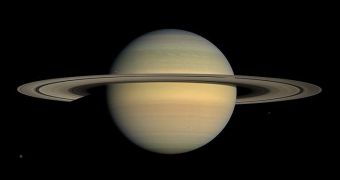When looking at a picture of Saturn in all its glory, you can easily see that the rings surrounding it look as sturdy as they come. They are continuously replenished by debris spewing out from a number of moons and are gravitationally bound to the gas giant itself. It would, therefore, appear that they cannot be easily influenced. Astronomers thought so too until, in 1984, a yet-unidentified event severely disrupted the thin rings, creating the vinyl-like, ridged and spiraled patterns we see even today.
It would appear that all of the telescopes, satellites and probes we had in space at the time missed the event, whatever it was. The changes that were made to the inner ring of the planet were so severe, that experts believe only a change in the planet's traits itself might have caused it. Astronomers didn't even find out about the changes until 2006, when the Cassini orbiter started sending back images of the unusually shaped rings, NewScientist reports.
In the D Ring, the closest to the surface of the planet, the space probe identified alternating bright and dark bands, which seemed to indicate that the icy ring was not entirely flat. Measurements then revealed that the ring was made up of grooves, each about a kilometer in height, which is something very unusual for Saturn's companions. Usually, they are very, very thin compared to their width and cannot be seen if an observer is placed exactly on top of them.
The latest image from Cassini did nothing to clear up the mystery. It only made it worse, when it showed that the grooves were significantly more widespread than first thought. As the gas giant pulled its ring-vanishing act a couple of months ago, astronomers had a chance to look at all rings as they were lit edge-on. They noticed, very much to their amazement, that the next companion, the 17,000-kilometer-wide C Ring, also had grooves in it. Their amplitude is, however, a bit smaller, of only 100 meters.
The fact that the second ring has the grooves too means that a comet or asteroid can be ruled out, experts argue. “The trouble is everything you come up with seems intrinsically unlikely,” SETI Institute expert Mark Showalter says.

 14 DAY TRIAL //
14 DAY TRIAL //